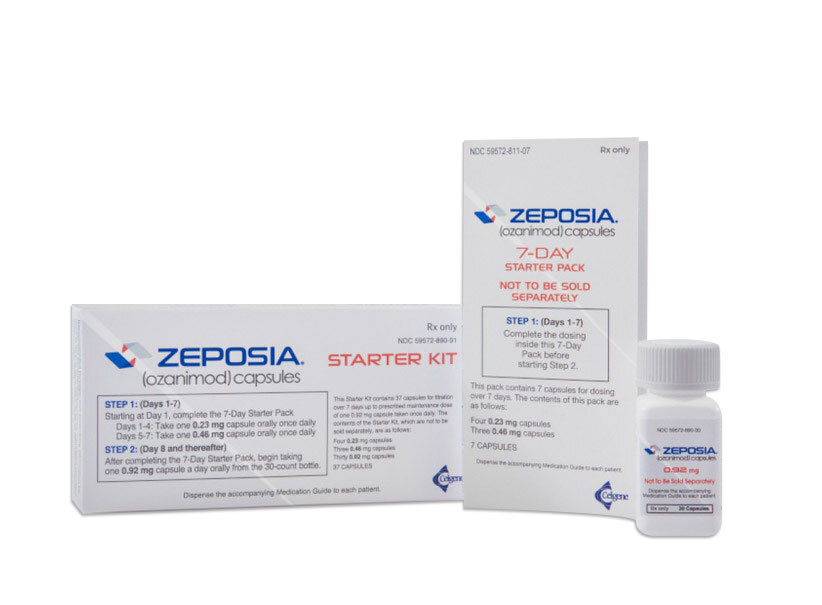Fampyra (fampridine) vs Zeposia (ozanimod)
Fampyra (fampridine) vs Zeposia (ozanimod)
Fampyra (fampridine) is a potassium channel blocker that is primarily prescribed to improve walking in patients with multiple sclerosis (MS) by increasing nerve signal conduction. In contrast, Zeposia (ozanimod) is a sphingosine 1-phosphate receptor modulator used to treat relapsing forms of MS, including clinically isolated syndrome, relapsing-remitting disease, and active secondary progressive disease, by reducing the immune system's attack on the nervous system. When deciding between the two, a patient should consider their specific type of MS, their symptoms (such as walking difficulties versus relapse prevention), and consult with their healthcare provider to determine which medication aligns best with their treatment goals and medical history.
Difference between Fampyra and Zeposia
| Metric | Fampyra (fampridine) | Zeposia (ozanimod) |
|---|---|---|
| Generic name | fampridine | ozanimod |
| Indications | Improvement of walking in patients with multiple sclerosis (MS) | Treatment of relapsing forms of multiple sclerosis (MS), including clinically isolated syndrome, relapsing-remitting disease, and active secondary progressive disease |
| Mechanism of action | Potassium channel blocker | Sphingosine 1-phosphate receptor modulator |
| Brand names | Fampyra | Zeposia |
| Administrative route | Oral | Oral |
| Side effects | Urinary tract infection, insomnia, dizziness, headache, nausea, weakness, back pain | Upper respiratory infection, elevated liver enzymes, orthostatic hypotension, hypertension, bradycardia, macular edema |
| Contraindications | History of seizures, moderate to severe renal impairment (CrCl ≤50 mL/min) | Recent (last 6 months) myocardial infarction, unstable angina, stroke, transient ischemic attack, decompensated heart failure requiring hospitalization, Class III/IV heart failure, presence of Mobitz type II second-degree or third-degree atrioventricular (AV) block, sick sinus syndrome, sinoatrial block, unless the patient has a functioning pacemaker |
| Drug class | Potassium channel blocker | Sphingosine 1-phosphate receptor modulator |
| Manufacturer | Biogen | Bristol Myers Squibb |
Efficacy
Fampyra (Fampridine) and Its Efficacy in Multiple Sclerosis
Fampyra, known generically as fampridine, is a medication approved for use in improving walking in patients with Multiple Sclerosis (MS). The active ingredient, fampridine, is a potassium channel blocker that enhances nerve signal conduction in damaged nerves. Clinical trials have demonstrated that fampridine can lead to a modest improvement in walking speed in some individuals with MS. The measure of efficacy is often based on an increase in walking speed as assessed by the Timed 25-Foot Walk (T25-FW) test. It is important to note that not all patients with MS respond to fampridine, and its efficacy may vary from person to person.
The effectiveness of Fampyra was evaluated in two main Phase III clinical trials. These trials included MS patients with walking disability, and the results showed that a significantly greater proportion of patients on fampridine had a consistent improvement in walking speed compared to those on placebo. The improvement was sustained over the 14-week treatment period. However, it is essential to consider that the degree of improvement in walking ability may be modest and not all patients will experience the same level of benefit.
Zeposia (Ozanimod) and Its Efficacy in Multiple Sclerosis
Zeposia, with the active ingredient ozanimod, is an oral medication approved for the treatment of relapsing forms of Multiple Sclerosis, including clinically isolated syndrome, relapsing-remitting disease, and active secondary progressive disease. Ozanimod is a sphingosine 1-phosphate receptor modulator that works by trapping immune cells in lymph nodes, thereby reducing their ability to enter the central nervous system and cause inflammation and demyelination. Clinical trials have shown that ozanimod is effective in reducing the annual relapse rate in patients with relapsing forms of MS when compared to a comparator drug, interferon beta-1a.
The efficacy of Zeposia was established through two pivotal Phase III trials, SUNBEAM and RADIANCE, which demonstrated that ozanimod significantly reduced the annualized relapse rate over the course of the trials compared to interferon beta-1a. Additionally, ozanimod was shown to reduce the number of new or enlarging T2 lesions and the number of gadolinium-enhancing lesions on MRI scans. These results indicate that ozanimod can effectively reduce disease activity in patients with relapsing forms of MS. However, as with all medications, individual responses to treatment can vary, and the long-term benefits and risks of ozanimod require further study.
Regulatory Agency Approvals
Fampyra
-
European Medical Agency (EMA), European Union

-
Food and Drug Administration (FDA), USA

-
Health Canada

-
Therapeutic Goods Administration (TGA), Australia

-
Medsafe (NZ)

Zeposia
-
European Medical Agency (EMA), European Union

-
Food and Drug Administration (FDA), USA

-
Health Canada

-
Therapeutic Goods Administration (TGA), Australia

Access Fampyra or Zeposia today
If Fampyra or Zeposia are not approved or available in your country (e.g. due to supply issues), you can access them via Everyone.org.
How it works

Make an enquiry
Choose the medicine you want to buy, answer a couple of questions, and upload your prescription to speed things up. We’ll get back to you within 24 hours.


Make an enquiry
Choose the medicine you want to buy, answer a couple of questions, and upload your prescription to speed things up. We’ll get back to you within 24 hours.


Breeze through the paperwork
We'll guide you through the required documents for importing unapproved medicine, ensuring you have all the necessary information.


Get a personalized quote
We’ll prepare a quote for you, including medicine costs and any shipping, administrative, or import fees that may apply.


Receive your medicine
Accept the quote and we’ll handle the rest - sourcing and safely delivering your medicine.

Some text on this page has been automatically generated. Speak to your physician before you start a new treatment or medication.
Let's talk
If you have any questions, call us or send us a message through WhatsApp or email:
Contact us




